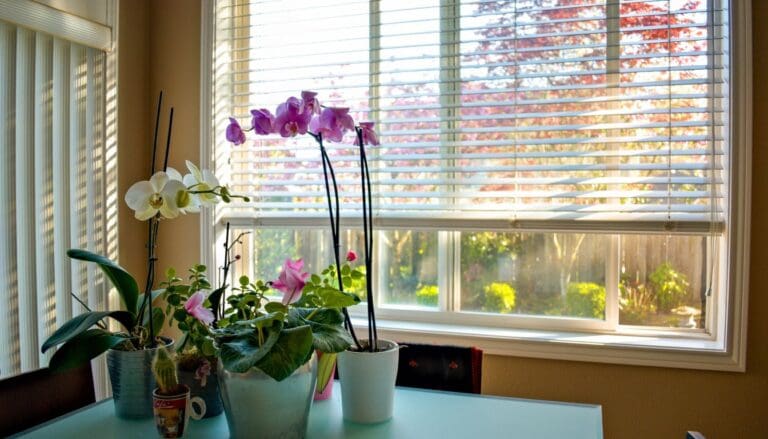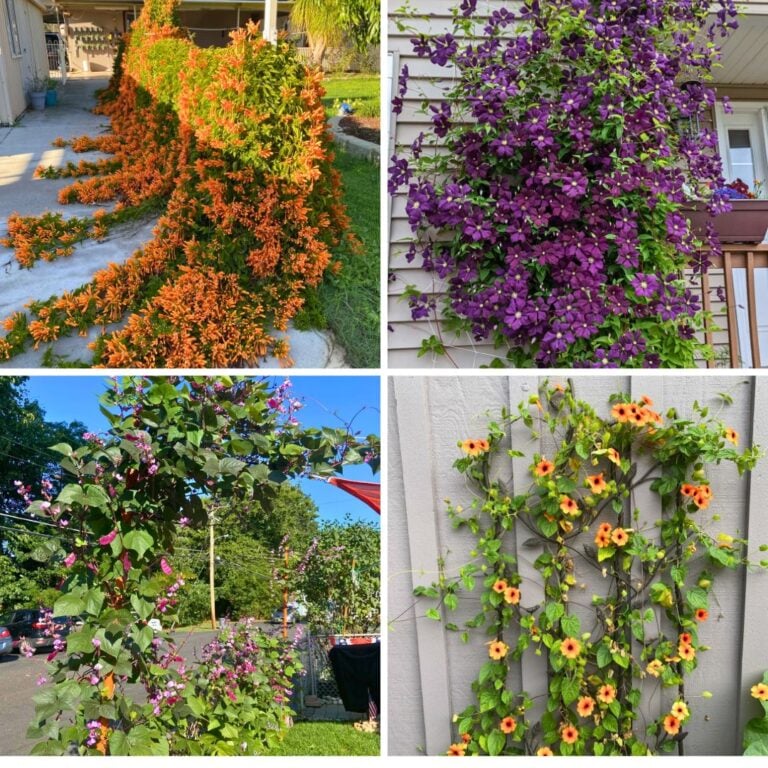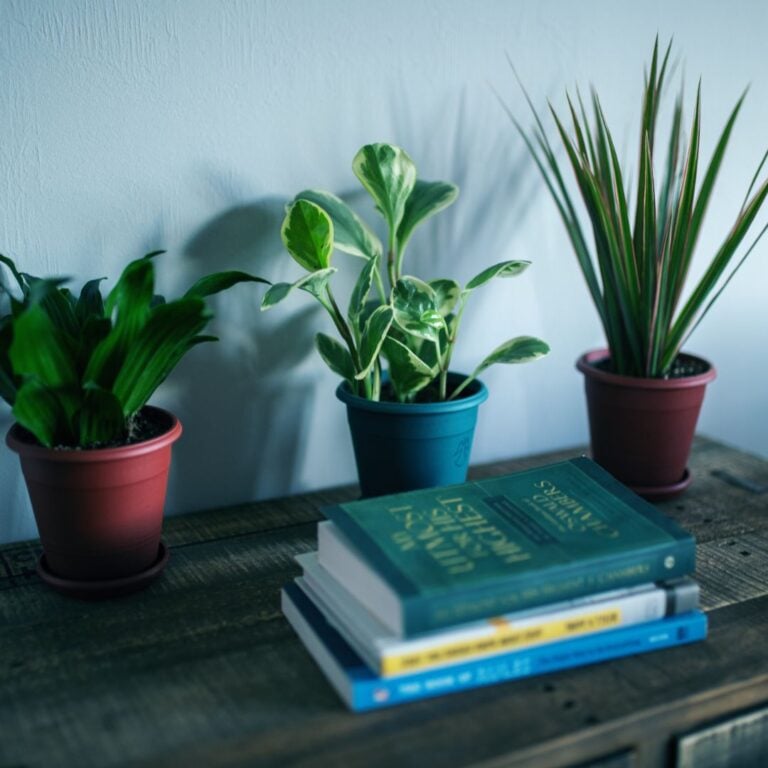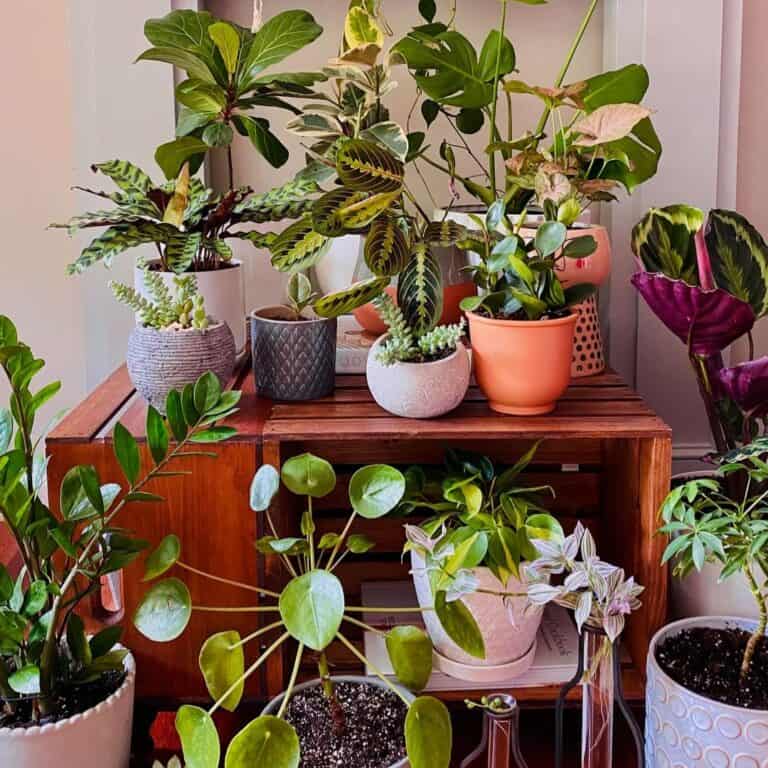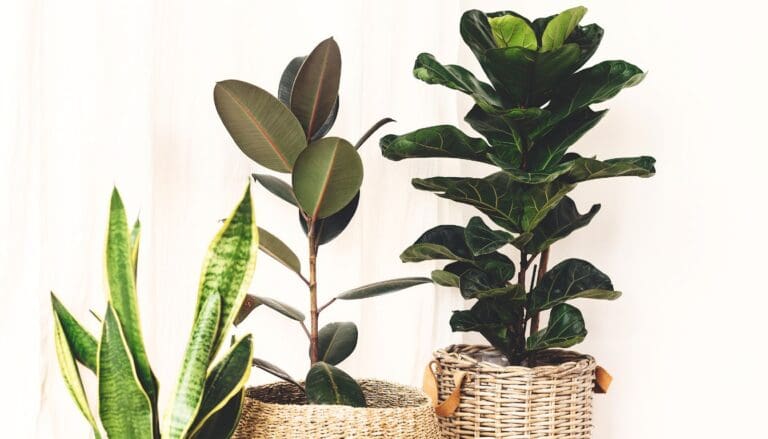20 Best Indoor Plants for Bedroom
Are you looking to add some life to your bedroom? 🌿 I’ve got just the thing for you!
Indoor plants not only brighten up your space, but they also improve air quality and bring a sense of calm.
Imagine waking up to a room full of fresh air and vibrant greenery—doesn’t that sound wonderful?
I’ve gathered a list of the 20 best indoor plants perfect for any bedroom. These plants are easy to care for, and some of them might even help you sleep better at night.
Whether you have a green thumb or are just starting out, there’s a plant for everyone.
Let’s dive in and explore, shall we? 🌱✨
Please note: Simplify Plants is reader-supported. As an Amazon Associate, I earn from qualifying purchases made by our readers with no extra cost added to you all! Some links in the post are affiliate links and I get a commission from purchases made through links in the post.
1) Snake Plant (Sansevieria)

Snake plants, also called Sansevieria, have great style and are super easy to care for.
They bring a cool touch to any bedroom with their tall, stiff leaves that can be striped, banded, or even solid.
I love how these plants can thrive even in low light. 🌿
This makes them perfect for rooms where natural light is limited. Plus, they don’t need a lot of water, so it’s hard to mess up.
Did you know that NASA listed them among the top plants for improving indoor air quality? 💚
This plant actually releases oxygen at night. It’s like your personal air purifier while you sleep!
There are several varieties to choose from, like ‘Black Gold’ with its striking yellow edges and ‘Skyline’, which has almost cylindrical leaves. Each type has its own unique charm.
Who doesn’t like a plant that’s both beautiful and practically indestructible? 😄
Whether you’re a plant newbie or a seasoned pro, a snake plant could be a perfect addition.
Do you already have a snake plant? Share your experiences in the comments below! 🪴💬
2) Peace Lily (Spathiphyllum)
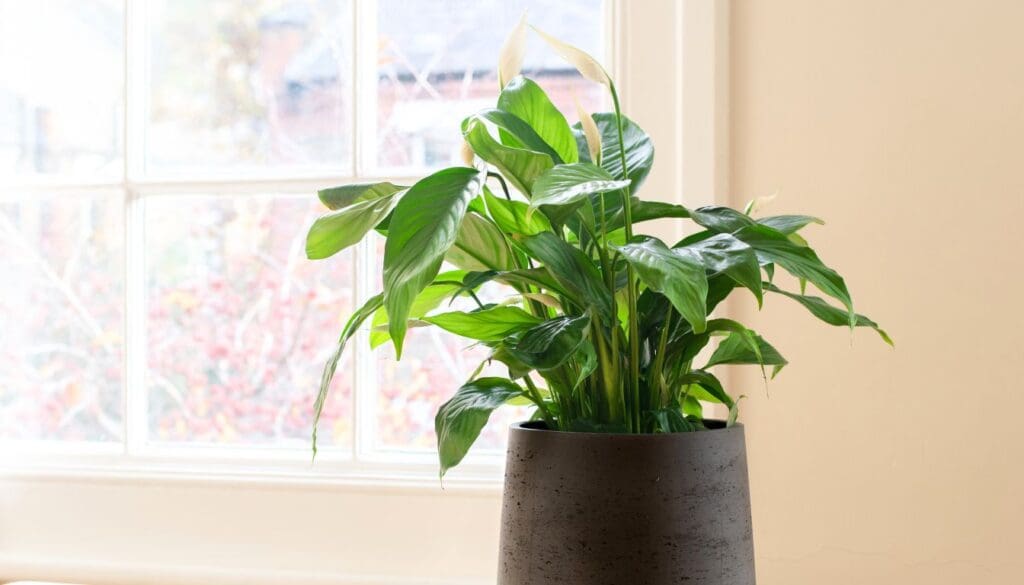
Peace Lilies are amazing plants that can make any bedroom feel welcoming and fresh. 🌸
These beauties are not just pretty to look at; they also help clean the air by removing toxins. I love how they add a touch of green while making the air healthier to breathe.
Peace Lilies thrive in temperatures between 65°F and 75°F. They enjoy bright, indirect light, but they can also do well in low light.
This makes them perfect for a bedroom since they don’t need direct sunlight.
You’ll love the striking white flowers that stand out against the dark green leaves. They look so elegant and can match any bedroom decor.
Plus, the plants can grow up to three to four feet tall, which is just right for a cozy corner.
These plants are pretty low-maintenance. 💧
Just water them once a week, but make sure the soil is moist, not soggy. If the leaves start to droop, it’s a sign they need more water.
One fun fact about Peace Lilies is that their shiny leaves can collect dust.
I like to give mine a gentle wipe every now and then to keep them looking their best. It’s kind of like giving my plant a little spa day!
There are several types of Peace Lilies, like the Mauna Loa Supreme which has large leaves and the Domino variety with cool white patterns on the leaves. Each type has its own unique charm.
Do you have a Peace Lily in your bedroom? How’s it doing? Let me know in the comments! 🌿✨
3) Aloe Vera
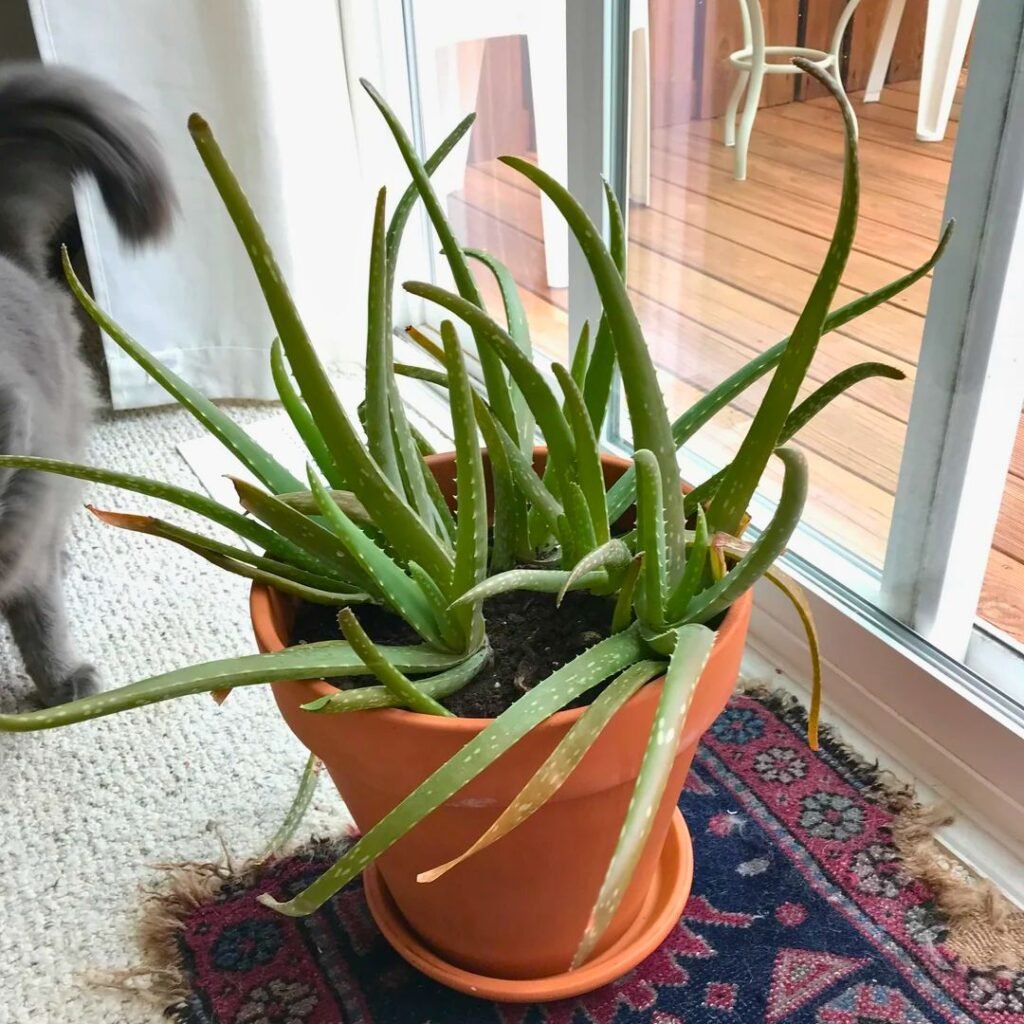
Aloe vera is one of my favorite plants to keep in the bedroom. It’s not just for sunburns!
This plant is super low-maintenance and perfect for anyone who might forget to water their plants now and then. 🙃
It thrives in bright light, so placing it by a sunny window is ideal. However, it can also handle low light, making it quite flexible.
Plus, you only need to water it sparingly – about every three weeks or so.
Aloe vera is also great for air quality. It helps to remove toxins from the air, which is always a bonus. 🌿
When you’re breathing cleaner air, it can make your sleep feel even more restful.
One cool thing about aloe vera is how it looks. With its thick, spiky leaves, it adds an interesting touch to any room.
And if you ever need some aloe for your skin, you can simply snip off a piece!
Have you ever tried keeping aloe vera in your bedroom? What was your experience like? Let me know in the comments below! 😊
4) English Ivy

English Ivy is a classic choice for a bedroom plant. Its elegant, cascading leaves can create a soothing atmosphere.
It’s easy to picture it trailing down a bookshelf or hanging basket. This plant is not just pretty; it’s great for air purification too. 🪴
What’s cool is that English Ivy thrives in indirect light. You don’t need a super sunny spot to keep it happy.
Just keep it in a cool room, between 50-75°F, and you’ll be good to go. Too hot, like above 90°F, and it might struggle.
Ivy also loves humid environments.
So, placing it in the bathroom or using a humidifier nearby can help it thrive. If you notice the leaves looking a bit dry, a light misting can make a big difference.💧
One thing to remember is that English Ivy grows quickly.
Don’t be surprised if you need to trim it back regularly to keep it looking neat. This can be a fun way to practice your gardening skills. ✂️
Do you have a favorite spot where you think English Ivy would look great? Let me know in the comments! 🌿
5) Spider Plant (Chlorophytum comosum)
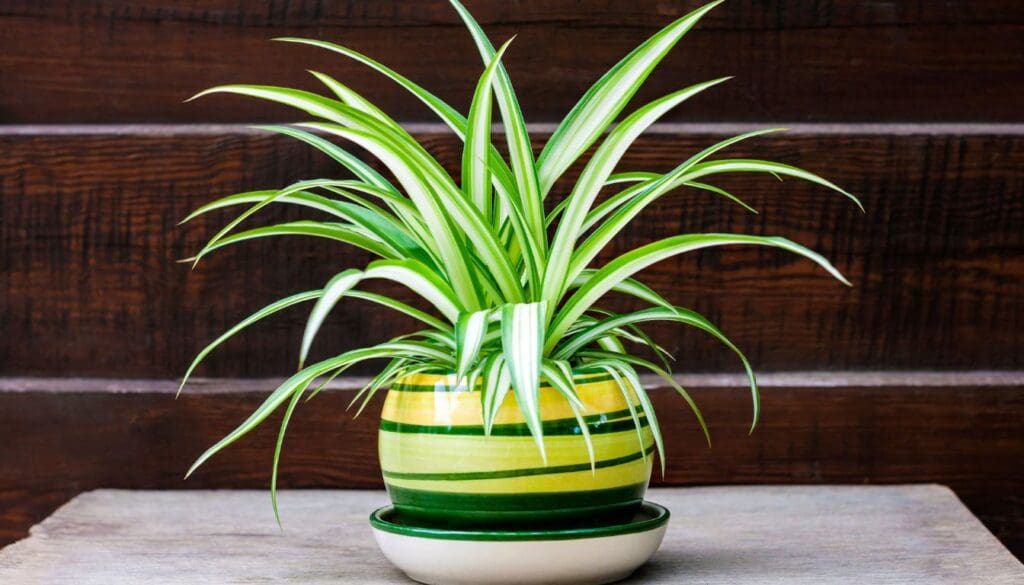
One of my favorite bedroom plants is the Spider Plant. 🌿
It’s not only easy to care for but also adds a fresh touch to any room. Its long, arching leaves with white stripes make it a standout.
Spider Plants are great because they don’t need a lot of attention.
I water mine about once a week in the spring and summer. In the winter, I let the soil dry a bit more between waterings.
Another cool thing is that they produce little “spiderettes” or baby plants.
These can be potted to grow new plants, which makes them perfect for sharing with friends. Just snip one off and place it in soil.
They thrive in bright to moderate light.
I’ve found that placing mine near a window with indirect sunlight works best. Make sure the room temperature is comfortable, as Spider Plants don’t like it too hot or too cold.
One thing to note 💧 is they can be sensitive to fluoride in tap water.
If you see brown tips on the leaves, try using filtered water instead.
I love how versatile they are. Whether in a hanging basket or a high shelf, Spider Plants always seem to look good.
Plus, they are great for air purification, making your bedroom feel fresher.
Do you have a Spider Plant in your bedroom? 🌱
If not, what’s stopping you from getting one? Let me know in the comments!
6) Jade Plant
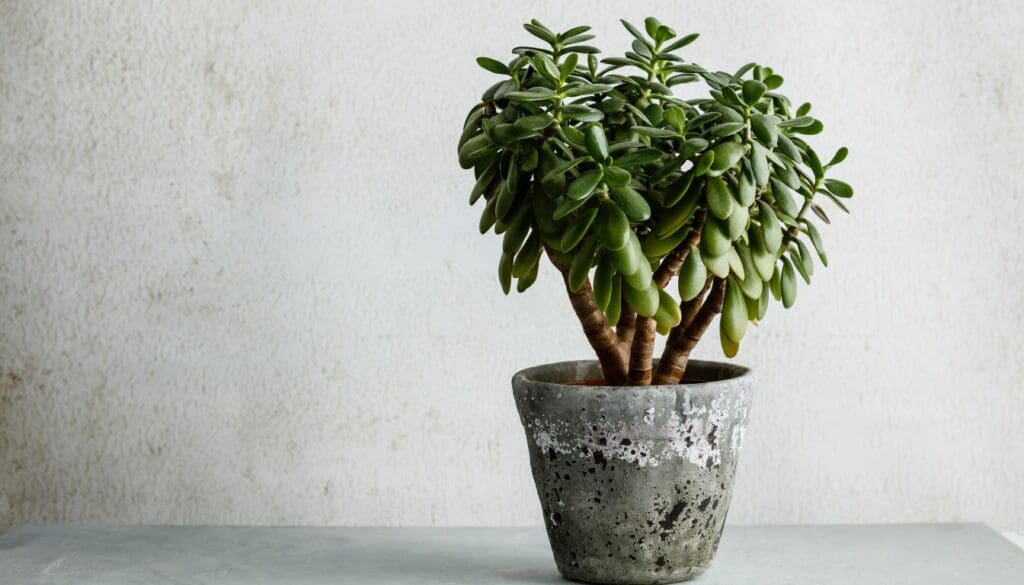
One of my favorite indoor plants for the bedroom is the Jade Plant. It’s not just beautiful but also super easy to care for!
Who doesn’t love low-maintenance greenery? 🪴
The Jade Plant thrives in bright, indirect sunlight. It’s perfect for a sunny windowsill. If you have one, make sure to place it there and watch it grow happily! 🌞
I find that watering these plants can be tricky if you’re not careful.
They love their soil to be moist but never soggy. I usually water mine more frequently in the spring and summer, but I always make sure the pot drains well.
Using a succulent potting mix can make a big difference.
Loose, well-draining soil prevents root rot and keeps the plant healthy. Have you tried mixing your own soil?
I’ve found that combining peat moss, compost, and sand works wonders!
Also, did you know that the Jade Plant is thought to attract wealth and prosperity? 🌟
According to Feng Shui, placing one in your room might just bring you some extra luck!
To top it off, Jade Plants act as natural air purifiers. They help remove harmful toxins from the air, making your bedroom a cleaner, healthier place to relax.
Got any tips or stories about your own Jade Plant? Share in the comments below! I’d love to hear how these lovely plants are brightening up your bedroom. 🌿💚
7) Pothos (Epipremnum aureum)
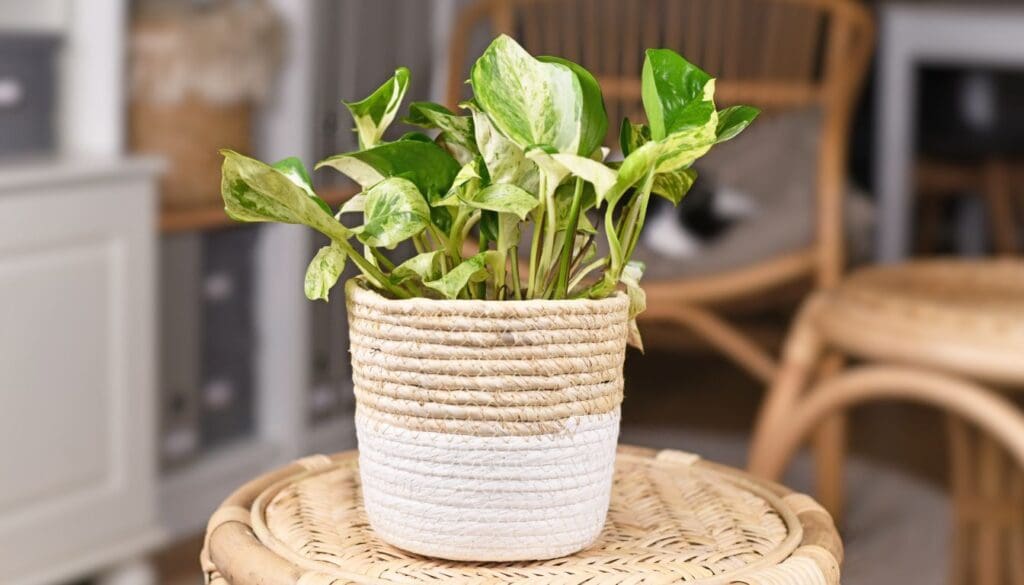
Let’s chat about Pothos, also known as Epipremnum aureum. If you’re new to indoor gardening, this is a fantastic plant to start with.
Pothos is super hardy and can thrive in various light conditions.
Whether your bedroom has bright, indirect light or lower light, it’s likely to do well. Plus, it’s known for its air-purifying properties, which is a great bonus for your sleep environment!
You don’t need to worry much about temperature swings.
Just keep it between 65°F and 80°F for the best growth. They can handle temperatures up to 90°F but try to avoid colder temps below 50°F.
Watering is pretty simple. Let the soil dry out completely between waterings.
Overwatering can lead to root rot, and nobody wants that! Less water is better than too much.
I love how versatile Pothos is. You can let its vines trail down from a shelf or hang it up high for a dramatic effect.
It’s also easy to propagate. Just snip a piece, pop it in water, and watch it grow roots!
Pothos thrives with a bit of extra love. Fertilize it monthly during the growing season to encourage lush, thick growth.
And, if you ever need to shape it, don’t hesitate to prune. It can handle a good haircut!
Ever named your plants? I do that all the time! My Pothos is named Vinnie because of his vines! 😂
Share your plant names in the comments; I’d love to hear them.
If you’re looking for a plant that adds a pop of green and is easy to care for, Pothos is your go-to. Just a little TLC, and it will thrive in your bedroom. 🌱✨
What’s your favorite thing about Pothos? Let me know in the comments! And don’t forget to share this with your friends who might need some plant inspiration.
8) ZZ Plant (Zamioculcas zamiifolia)

I love the ZZ Plant, also known as Zamioculcas zamiifolia. It’s a perfect addition to any bedroom. 🌿
This plant is as tough as nails and can thrive in low light, making it ideal for rooms without much natural sunlight. Plus, it’s nearly impossible to kill, even if you forget to water it for a while!
ZZ Plants have thick, waxy leaves that shine and add a bit of elegance to any space. They look great on a nightstand, windowsill, or even on the floor in a decorative pot.
Their sleek, green foliage can complement any decor style, whether it’s modern or traditional.
Another reason to love the ZZ Plant is that it’s low maintenance.
Just water it every couple of weeks and make sure the soil is completely dry before watering again. Too much water can cause root rot, but don’t worry—this plant is very forgiving.
ZZ Plants also don’t need much fuss when it comes to potting.
It’s best to use a container with good drainage. Any standard potting mix will work.
Place your plant in bright, indirect light for optimal growth, but it can also handle low light if that’s what you have.
Are you worried about pests? 🐜
ZZ Plants are pretty resistant to most pests. If you do see dust accumulating on the leaves or any pest infestation, just wipe the leaves clean or apply some horticultural oil.
One helpful tip is to fertilize your ZZ Plant with a balanced liquid fertilizer diluted to half strength.
Do this about once every month during the growing season (spring and summer). When colder months come around, reduce fertilizing to once every six months.
Do you have a ZZ Plant in your bedroom? If you do, share a picture in the comments! 📸 If not, would you consider getting one now? I’d love to hear your thoughts. 🌱
9) Lavender

I love having lavender in my bedroom! This plant not only looks pretty, but its calming scent can help me sleep better. 🌸
Lavender thrives in bright light, so I place it near a south-facing window. It needs at least three to four hours of direct sunlight each day.
When watering, I drench the soil thoroughly and ensure the pot has good drainage.
If my lavender starts leaning towards the light, I just rotate the pot a quarter turn when I water it. 🌿 This helps the plant grow evenly.
Temperature matters too.
I keep my room between 60°F to 70°F during the day. At night, I let it drop by about 10 degrees to mimic natural conditions.
Lavender prefers low humidity. So, I avoid placing it near humidifiers or areas with high moisture. 🚫💧
Caring for lavender is quite simple.
I gently massage the roots before potting to stimulate growth. Also, maintaining a tidy plant is easy with regular care.
Do you have lavender in your bedroom? Share your experiences in the comments! I’d love to hear how it improves your space. 🌿🛏️
10) Philodendron

Alright, let’s talk about one of my favorite houseplants: Philodendron. These plants are super easy to care for, making them perfect for beginners.
They come in a variety of shapes and sizes, so there’s a philodendron for every taste and space.
One of the best things about philodendrons is their low maintenance.
Just pop them in a spot with bright to medium indirect light and make sure to water them when the soil feels dry. That’s it! They’ll thrive without much fuss.
Ever heard of the Heartleaf Philodendron?
It’s a classic choice with its cute, heart-shaped leaves. This plant can grow up to 3-13 feet long, making it perfect for hanging baskets or tall shelves. It adds a lovely green touch to any room.
Then there’s the Philodendron Majestic. This guy has velvety leaves with green and silver patterns that look stunning.
Its foliage can grow up to 2 feet long and a foot across. Quite impressive, right?
Another cool variety is the Philodendron Birkin.
It has unique white stripes on green leaves, making it stand out among other plants. It’s like a little piece of art right in your bedroom!
What’s your favorite philodendron?
Got one already, or maybe you’re thinking of adding one to your collection? 🌿
Share your thoughts in the comments!
11) Chinese Evergreen (Aglaonema)

One of my favorite bedroom plants is the Chinese Evergreen (Aglaonema). It’s not just beautiful but also really easy to care for! 🌿
This plant thrives in indirect light. So, you don’t need to worry about placing it right by a window. In fact, it prefers a bit of shade. How cool is that?
Keeping the soil moist is important, but let the top inch of soil dry out between waterings.
I sometimes water it from the bottom, which seems to keep it happy for longer periods without needing frequent waterings.
Let’s talk about the look.
Chinese Evergreen comes in various types, like the trendy Silver Bay. Its leaves can grow up to 10 inches long, creating a lush, green display in your bedroom.
Another great thing about this plant is its adaptability.
It can handle a bit of neglect, making it perfect for beginners or anyone with a busy schedule. Plus, it’s known to resist common pests, although it’s not completely immune. Spider mites, scale insects, and mealybugs can sometimes make an appearance.
One quirky thing I do is keep my Chinese Evergreen in my bathroom. With the humidity from showers and a bit of light, it absolutely thrives there! 🚿
Ever had a houseplant with brown spots?
Sometimes, this can happen if the Chinese Evergreen gets too much direct sunlight. Moving it to a shadier spot often solves the problem.
Do you have a Chinese Evergreen in your bedroom?
If not, what’s stopping you? 🌱
Share your thoughts in the comments! 😊
12) Dracaena

Dracaena is a fantastic choice for any bedroom! 🌿 This plant is not only hardy but also very low-maintenance, making it perfect for those of us who are busy or maybe not the best at keeping plants alive. Plus, it adds a pop of green that can brighten up any space.
One of the most popular varieties is the Lucky Bamboo.
Even though it isn’t real bamboo, its unique look can add a touch of elegance to your room. Another great option is the Dracaena Fragrans, which can help purify the air and create a healthier environment for you to sleep in.
Dracaena plants can thrive in low light conditions. So don’t worry if your bedroom doesn’t get a lot of natural light. They also don’t need frequent watering. Just a little once the soil feels dry will do the trick.
Did you know these plants can grow quite tall?
Some can even reach up to 7 feet! But don’t worry, they’re also available in smaller sizes if you prefer a more compact plant.
What about you? Have you tried keeping a Dracaena in your bedroom? Share your experiences in the comments! 🌱💬
13) Bamboo Palm (Chamaedorea seifrizii)
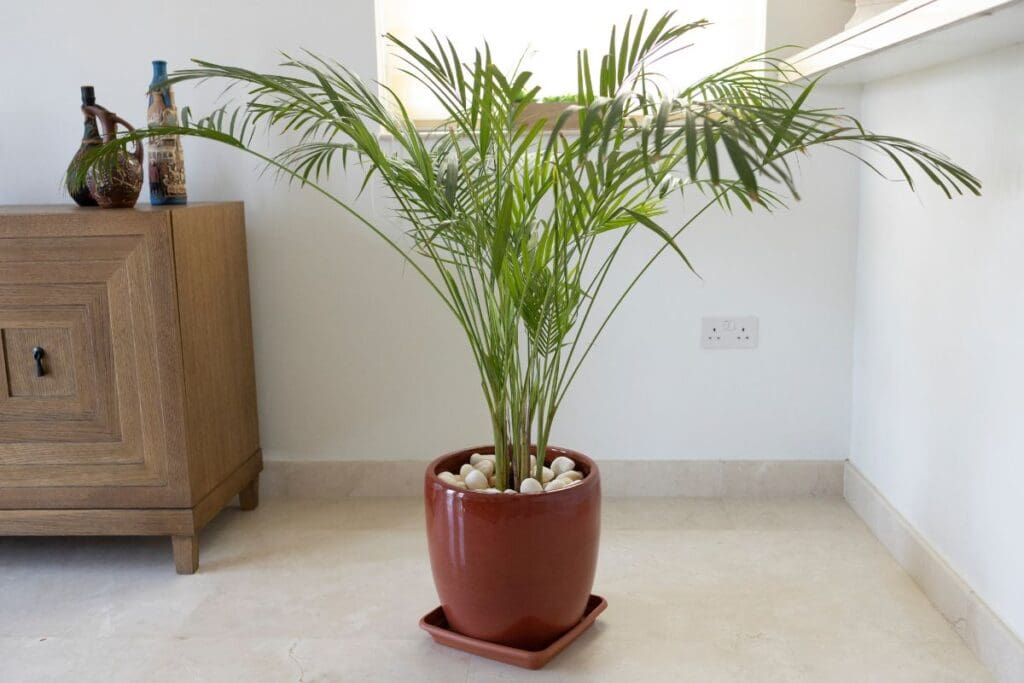
The Bamboo Palm is one of my top picks for a bedroom plant. It’s got these slender, bamboo-like stalks that look super charming and give off a tropical vibe. 🌴
The fronds are deep green and can grow up to 2 feet long, adding a touch of elegance to any corner of your room.
One of the best things about the Bamboo Palm is its air-purifying properties. It’s like having a mini forest in your bedroom, helping to keep the air clean and fresh. Perfect for a good night’s sleep, right? 💤
Caring for this plant is quite easy.
It likes bright, indirect light but can tolerate low light conditions, making it adaptable to various spots. Just keep it away from direct sunlight to prevent leaf burn.
When it comes to watering, the Bamboo Palm prefers its soil to be slightly moist.
I usually water mine once a week, making sure the soil doesn’t get too soggy. Adding a layer of gravel at the bottom of the pot can help with drainage.
This plant grows quite tall, reaching heights of up to 10 feet indoors, though it typically stays around 6-7 feet. It’s a great way to fill up vertical space without taking up too much floor area.
If you’re a beginner, don’t worry! The Bamboo Palm is very forgiving.
With a little bit of love and care, it will thrive and add a lush, green presence to your bedroom.
What do you think? Do you already have a Bamboo Palm, or is it on your wishlist? Let me know in the comments! 🌿💬
14) Lady Palm (Rhapis excelsa)

Have you met the Lady Palm? 🌿 This little beauty, known scientifically as Rhapis excelsa, is a fantastic addition to any bedroom.
I love how low-maintenance this palm is. It thrives in bright, indirect light, making it perfect for that sunny corner of your room. But don’t worry if your bedroom isn’t super bright; it can tolerate lower light levels too.
What’s cool about the Lady Palm is its distinctive fan-shaped leaves. These glossy, dark green leaves give it a tropical vibe. Plus, the plant’s slender, bamboo-like canes add a touch of elegance.
Watering this palm is pretty straightforward.
During the summer, water it when the top inch of soil feels dry. In winter, let the top two inches dry out before watering again. Easy peasy, right? 💧
Did you know Lady Palms can reach up to 6 feet indoors? That’s almost like having a mini palm tree right in your bedroom! It’s also quite hardy, tolerating temperatures between 50°F and 77°F.
The Lady Palm is not just a looker; it’s also a cleaner!
This green friend can help improve indoor air quality, making your bedroom a healthier place to relax and unwind. 🌱
Don’t let cold drafts get to your Lady Palm; it’s essential to keep it away from windows that get chilly. Give it a cozy spot in your bedroom, and it’ll reward you with lush, vibrant foliage.
Ever tried dividing your plants?
Lady Palms grow in clumps, so you can easily separate them to create more plants! Just look for natural divisions and ensure each section has enough roots and at least one healthy stem.
What do you think? Are you ready to add a Lady Palm to your home? Drop a comment below and let me know! 🏡💚
15) Areca Palm (Dypsis lutescens)
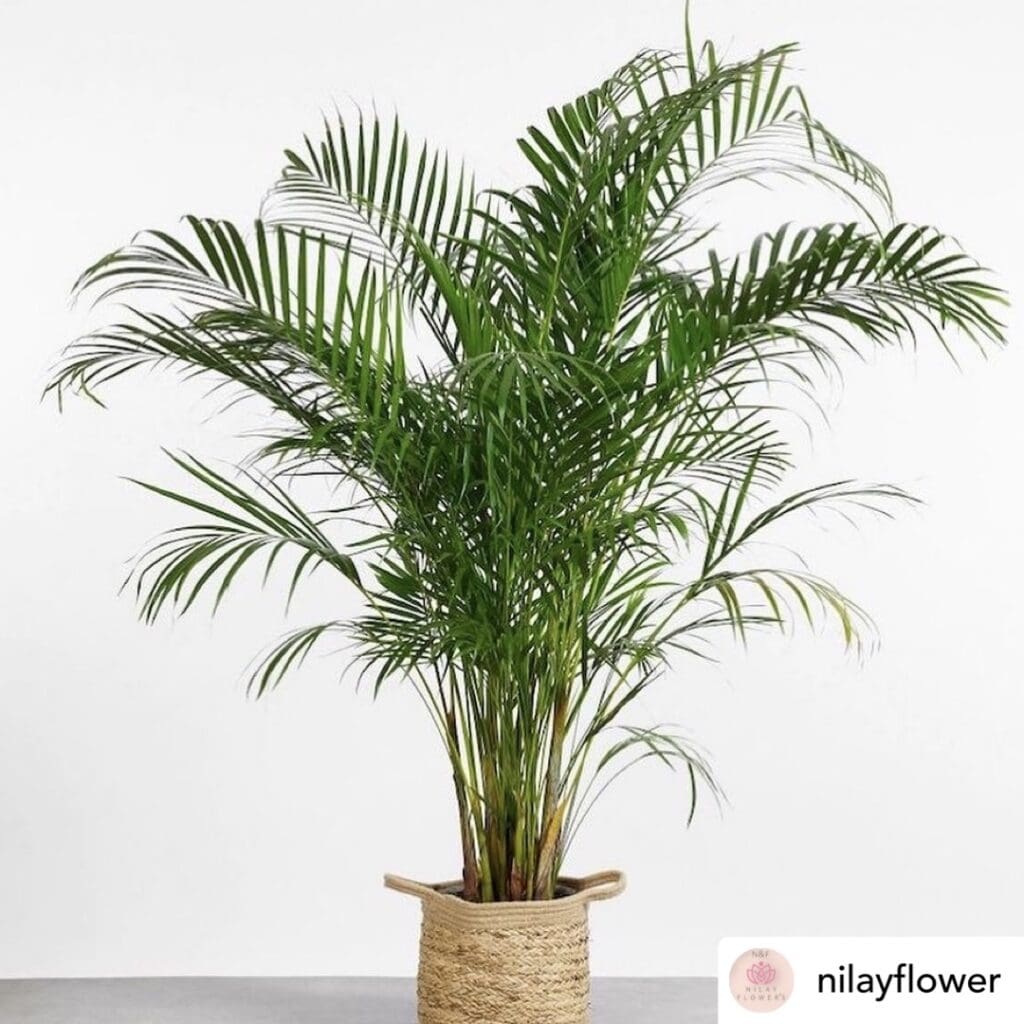
I’m super excited to introduce you to the Areca Palm! 🌴 This beauty is also known as the butterfly palm or golden cane palm.
It’s a fantastic addition to the bedroom with its long, arching fronds and elegant look.
The Areca Palm loves bright, indirect sunlight.
If you place it near a window with filtered light, it’ll thrive and bring a tropical vibe to your space.
Just be sure not to expose it to direct sunlight for too long, as it can scorch those lovely fronds.
When it comes to watering, it’s all about balance.
I water my Areca Palm when the top inch of soil feels dry.
During the fall and winter months, I usually water it once a week to once every 10 days.
This keeps the soil moist without overdoing it.
A little secret? 🌿 Areca Palms enjoy high humidity!
You might want to mist the leaves occasionally or use a humidifier to keep the air around it nice and humid.
In terms of temperature, these palms are quite content between 65°F and 75°F.
They prefer slightly acidic soil, so I use well-draining soil that’s rich in organic matter.
Plus, this plant is not just a pretty face—it helps purify the air in your bedroom, making it a healthier place to rest. 🌸
Do you have an Areca Palm in your home? Share your care tips or any fun stories in the comments below! 💬
16) Rubber Plant (Ficus elastica)

I love having a Rubber Plant in my bedroom! 🌿 It’s such a resilient and attractive plant that really livens up the space.
The Ficus elastica has beautiful, glossy leaves that can range from deep green to burgundy, adding a splash of color and elegance to any room.
One of the reasons I recommend this plant is because it’s so easy to care for.
It thrives in a variety of indoor environments, making it perfect for beginners.
Just make sure to place it in a spot with bright, indirect light.
If you have a windowsill that gets morning sun, that’s ideal!
When it comes to soil, the Rubber Plant prefers a well-draining mix.
I like to use a combination of commercial potting soil, perlite, and a bit of pine bark. This ensures good drainage and keeps the roots happy. 😄
Watering is pretty straightforward—a deep watering once the top inch of soil is dry does the trick.
Be careful not to overwater, though. Nobody likes a soggy plant!
Do you ever feel like your bedroom air is a bit stuffy?
The Rubber Plant can help with that!
It’s known for its air-purifying qualities, which is a great bonus for better sleep.
Don’t forget to wipe the leaves occasionally.
Dust can accumulate and block the light, which the plant needs to grow. Plus, shiny leaves just look nicer!
Have you had any success with Rubber Plants? I’m curious to hear your tips and stories! 🌱 Drop them in the comments below and let’s chat!
17) Boston Fern (Nephrolepis exaltata)

Boston Ferns are one of my personal favorites for the bedroom! 🌿 They bring a lush, green vibe that I absolutely love.
These ferns thrive in medium indirect light. Too much direct sunlight can cause their fronds to turn light green or even burn.
I usually keep mine near a window with sheer curtains to filter the light.
Watering is crucial. Boston Ferns prefer moist, rich, loamy soil that drains well.
During the growing season, I water my fern once or twice a week.
Just be careful not to overwater; nobody likes root rot, and it can seriously harm your plant.
Temperature-wise, Boston Ferns are pretty accommodating.
They grow best between 60-75°F (15-24°C). They can handle lows down to 50°F (10°C) and highs up to 95°F (35°C), but it’s best to avoid extremes for long periods.
I also fertilize my Boston Fern once a month during the growing season with a balanced fertilizer (look for something like 10-10-10 or 20-20-20).
This keeps the fern happy and healthy with the right balance of nutrients.
And don’t forget about humidity! These ferns love humid environments.
If your bedroom is dry, a little misting or a humidifier can go a long way in keeping your fern looking vibrant.
So, what do you think of adding a Boston Fern to your bedroom? 🌺 They’re beautiful and relatively easy to care for, plus they add a fresh, relaxing feel to any space. Let me know your thoughts in the comments! 💬
18) Maidenhair Fern (Adiantum)

The Maidenhair Fern is a lovely and delicate plant that adds a touch of elegance to any bedroom.
This fern is famous for its beautiful fronds that look like a lot of tiny leaves on dark, thin stems. 🌿 The fronds can look so light and airy, almost like a fairy’s wings.
One cool thing about this plant is its preference for high humidity.
It loves a bathroom with a shower nearby, which means placing it in your bedroom might involve some creativity to keep it happy. Daily misting works wonders! Got a humidifier? Perfect! Your fern will thank you.
Maidenhair ferns like rich, well-drained soil. Keeping the soil moist but not soggy is the trick.
Too dry or too wet, and this fern starts to fuss! Think of it as the Goldilocks of plants—it likes everything just right. And a little well-rotted compost mixed in can give it the nutrients it needs.
Another interesting fact is that there are different types of Maidenhair Ferns.
The Northern Maidenhair Fern and the Western Maidenhair Fern are popular types.
The Northern type is from eastern North America and parts of Asia, while the Western kind is from the west coast of North America, often found near waterfalls.
Maidenhair Ferns also have a graceful, arching habit. This means they don’t just grow up; they elegantly bend and curve, making them a living piece of art in your room.
I also discovered that ferns like these can be a bit of a diva—too much light, and they get sunburned; too little light, and they sulk.
They’re happiest in indirect light, like from a north-facing window. Who knew ferns could be so particular, right?
Do you already have one of these beauties at home? Or thinking about getting one? Share a picture or leave a comment below! 😊
19) Bird’s Nest Fern (Asplenium nidus)

Looking for an easy-to-care-for plant that adds a touch of green to your bedroom? The Bird’s Nest Fern is a great choice! 🌿
This fern features lush, wavy leaves that can really brighten up a room. I love how it thrives in indirect light, making it perfect for north-facing windows or any spot that doesn’t get too much direct sunlight.
Bird’s Nest Ferns prefer their soil to be evenly moist but not waterlogged.
Picture this: a damp sponge, not soggy! Using a peat-based potting mix with good drainage is key to keeping your plant happy.
Temperature-wise, these ferns are pretty accommodating but prefer a range between 60°F and 80°F.
Let’s be honest, who doesn’t like a cozy room? Just make sure it doesn’t get too cold at night.
For optimal growth, consider using a balanced liquid houseplant fertilizer diluted to half strength.
I usually fertilize mine monthly during the active growing season in spring and summer.
These ferns also love humidity.
If your bedroom is on the drier side, think about using a humidifier or placing a tray with water near the plant to keep it content. You could even mist the leaves lightly—make it a fun daily ritual!
Do you have a Bird’s Nest Fern in your bedroom? How’s it going? Share your experiences in the comments! 😊
20) Parlor Palm (Chamaedorea elegans)

I absolutely love the Parlor Palm for bedrooms. It’s perfect if you’re looking for a plant that’s easy to take care of and adds a touch of green to your space 🌿.
The Parlor Palm usually grows to about 2-6 feet tall indoors. That’s ideal for small spaces or cozy corners. It won’t take over your room, but it will definitely make its presence felt.
These plants like bright, indirect light.
I usually place mine near a north-facing window. Too much direct sunlight can scorch their leaves. Have you found the perfect spot in your bedroom yet?
Watering is pretty straightforward. Just make sure the soil is well-drained and not waterlogged.
I water mine when the top inch of soil feels dry. Overwatering can lead to root rot, which isn’t fun for anyone.
The Parlor Palm’s small, yellow flowers aren’t something you need to worry about when grown indoors. They rarely bloom inside, which I think is a plus. Less mess to clean up!
I also love that they can handle a range of temperatures.
They thrive in temperatures between 65°F and 75°F. How cool is that?
Using a balanced liquid houseplant fertilizer diluted to 50% once a month during spring and summer helps them grow happy and healthy.
During winter, no fertilizer is needed. Do you have a favorite type of fertilizer for your plants?
So if you’re looking to add some green and breathe life into your bedroom, the Parlor Palm is a fantastic choice. Give it a try! 🌱
Share your experience with growing Parlor Palms in the comments!
Benefits of Indoor Plants for Bedrooms
Bringing plants into the bedroom doesn’t just add a pop of color 🌿. These green buddies also boost air quality and enhance our mood and wellness. Let’s dig into how they do that.
Improved Air Quality
Cleaner air, anyone? Many plants act like natural air filters, removing toxins from the air.
Plants like the Peace Lily or Spider Plant are champs at this. They absorb pollutants such as formaldehyde, benzene, and carbon monoxide through their leaves.
This means I can wake up feeling refreshed, not stuffy.
Do you know that plants also produce oxygen?
At night, most plants release oxygen, which can help me breathe easier. Some even continue photosynthesis in low light.
For example, the Snake Plant is a night-owl, releasing oxygen while I sleep. Not bad for my bedroom buddy, right?
Enhanced Mood and Wellness
Having indoor plants in my bedroom isn’t just about looks 🌸. They make me feel happier and calmer.
Studies show that just being around plants can reduce stress and anxiety.
For instance, a Lavender plant not only looks lovely but its scent can help me relax and sleep better.
Have you ever noticed how tending to plants feels therapeutic? It’s true!
Taking care of my Aloe Vera or Pothos gives me a sense of purpose and accomplishment.
Plus, plants can improve concentration and productivity.
So, if I read or work from my bedroom, having plants around can help me stay focused.
What about you? Do you have a favorite plant that makes your space feel like a mini oasis? Share your thoughts in the comments below! 😊
How to Care for Indoor Plants in the Bedroom
Taking care of indoor plants can be fun and rewarding!
It’s important to pay attention to light, watering, and humidity to keep your plants happy and thriving. Here’s how:
Light Requirements
Most bedroom plants prefer indirect light.
If you have a window with sheer curtains, it’s perfect for diffusing the sunlight.
For plants like Dracaenas and Philodendrons, they can handle lower light levels, which makes them versatile for various bedroom spots.
If you don’t get much natural light, consider using grow lights. 🌱
These can supplement the light your plants need without taking up much space.
Keep an eye on your plants’ leaves. If they start to look pale or stretched out, they might be light-stressed.
Watering Tips
Watering can be tricky. Overwatering is one of the most common mistakes!
Always check if the top inch of the soil is dry before watering.
Use your finger to test or a moisture meter if you have one.
Different plants have different needs.
For instance, succulents need less water compared to ferns.
Make sure your pots have drainage holes, so excess water doesn’t sit and cause root rot.
A good rule of thumb is to water less frequently, but more thoroughly.
Humidity and Temperature Control
Bedrooms tend to be drier, especially with air conditioning or heaters running.
Plants like the Parlor Palm and Fiddle Leaf Fig thrive with a bit more humidity.
You can mist their leaves or use a humidifier to maintain moisture.
Most indoor plants prefer temperatures between 60-75°F.
Avoid placing them near vents or drafts where sudden temperature changes occur.
If the air in your room feels too dry, try grouping your plants together.
This creates a mini-ecosystem that helps maintain humidity levels.
Conclusion
Bringing plants into your bedroom can seriously transform the space. They don’t just look good—they make you feel good, too. 🌱
I’ve shared some of my favorite plants that are easy to care for and can improve air quality and relaxation.
From the stylish Monstera to the fragrant Jasmine, there’s something for everyone.
Got a favorite from the list? Share it in the comments! I’d love to know what works best for you. 🪴✨
Choosing the right plant can be a fun way to personalize your space.
Don’t forget to snap a pic of your new green friend and tag me—I can’t wait to see your indoor garden grow! 📸🌿
Note: Some images in the articles are sourced from Reddit and Other Platforms For Reference Purpose.

